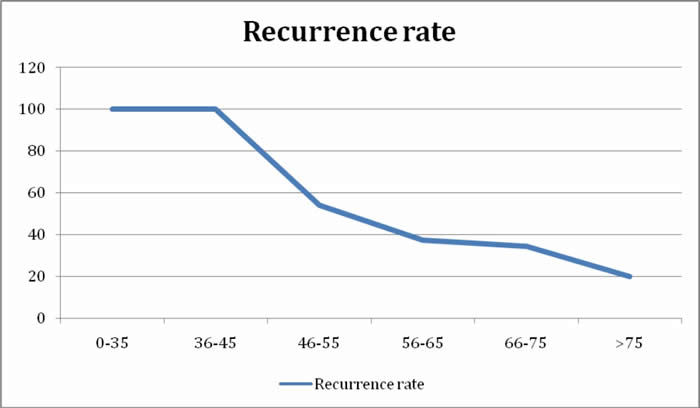Potential side effects of needle aponeurotomy (also called NA or PNF)
Although little data are yet available the drawback probably is that the recurrence rate is higher than with surgery because contracting cords are not removed. The data for needle aponevrotomy (the "French" term for NA) on immediate and long term side effects are somewhat limited, we therefore refer to the data published by Dr. Badois in 1995:
Treated: 799 patients, 992 hands in 1,557 sessions with 3,736 aponevrotomies (needle aponeurotomies).
ADVERSE EVENTS / ACCIDENTS :
Cracks/ breaks of the skin ...... : 75
Minor nerve injuries ............... : 29
Chronic pains ....................... : 12
Minor infections .................... : 7
Faintness ............................ : 6
Inflammatory reactions .......... : 4
Hematomas ......................... : 3
Flexor tendon ruptures ........... : 2
The relative high number of skin breaks is due to the procedure where the previously bent finger is straightened. Usually these breaks are not critical and heal well. The rate of nerve damage of .8 percent (normalized to the number of aponevrotomies) is about half of the rate observed in surgery, which amounts to about 1.5 percent (or higher, depending on the publication). The total rate of side effects amounts for NA to about 4 percent as compared to 15 - 20 percent for surgery (e.g. Sibbit WL Jr, Sibbit RR, Fibrosing syndromes: Dupuytren's contracture, diabetic stiff hand syndrome, plantar fasciitis, and retroperitoneal fibrosis, in WJ Koopman, ed., Arthritis and Allied Conditions, 14th ed., vol. 2 (Philadelphia 2001) pp. 2054–2066). Yet this comparison needs to be viewed with some caution because it has been questioned whether the samples in both studies were comparable.
A follow up study was recently presented by Foucher G, Medina J, and Navarro R "Percutaneous needle aponeurotomy: complications and results" The Journal of Hand Surgery : Journal of the British Society for Surgery of the Hand, Vol. 28/5 (2003), p 427-431 (see abstract). From their conclusions: "Complications were scarce, no infection or tendon injury but one digital nerve was found injured during a second procedure. ... In the group assessed at 3.2 years follow up, the recurrence rate was 58% ... The ideal indication for this simple and reliable technique is an elderly patient with a bowing cord and predominant MP contracture."
Post NA treatment and splinting
Post NA treatment is simple: the wound should be kept sterile until it is healed. Otherwise the hand can be fully used after a few days.
Recurrence is an issue with NA, possibly even bigger than with surgery. To avoid or postpone recurrence it might make sense to regularly wear a night splint for 3 - 6 month after NA. The splint should not be worn during the day to avoid stiffening of the related joint(s). We need to mention that the positive effect of such a night splint is not proven by research, actually there is hardly any research at all about night splinting of Dupuytren's contracture, but patients comment positively about its effect.
For wearing a night splint for 3 - 6 months the splint needs to be comfortable and easy to use. On our surgery page we are showing a comfortable glove splint (FixxGlove_on_Internet). Below is an example of a very convenient custom made night splint for the PIP joint of the little (pinkie) finger. It is simply pushed onto the finger in the evening and pulled of in the morning. The splint can be extended to support the base (MCP) joint as well and the same technique can be used for other fingers.
Simple and very comfortable custom made night splint
Recurrence after NA
Limited data are available on the recurrence after NA. Ideally one would be able to predict how long the average recurrence period would be, i.e. how long it would take on an average before another treatment, NA or surgery, is required. Instead patients are typically reviewed after a certain period of time and a percentage is given how many again experienced contracture of the previously treated finger. For example AL van Rijssen, H ter Linden and PM Werker "Three-Year Results of First-Ever Randomized Clinical Trial on Treatment in Dupuytren’s Disease: Percutaneous Needle Fasciotomy Versus Limited Fasciectomy" (in Ch. Eaton et al. (Eds.) "Dupuytren's Disease and related Hyperproliferated Disorders", Springer 2012, pp 281-292). After 33 months they report a recurrence rate of 65 %. The authors do not indicate whether and how long patients were wearing night splints after they had NA. While splinting after NA might have postponed recurrence significantly the data of this study show that recurrence is depending on age at time of treatment:

Recurrence rate of patients treated with NA after 3 years. Note that above data include a small number of fascietomies which show the same trend. From: A. van Rijssen et al. "Three-Year Results of First-Ever Randomized Clinical Trial on Treatment of Dupuytren's Disease" in C. Eaton et al. (Eds.) "Dupuytren's Disease and related Hyperproliferative Disorders", Springer, Heidelberg 2012, p 281-288). Reprinted with permission by Springer.
Page last modified:
01/11/2017